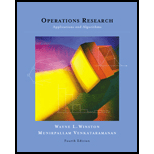
Explanation of Solution
The given problem is such that PSI believes that it will need the following amounts of generating capacity during the next five years.
The data is given in the table below:
TABLE 1:
| Year | Generating capacity (million kwh) |
| 1 | 80 |
| 2 | 100 |
| 3 | 120 |
| 4 | 140 |
| 5 | 160 |
Further the company has a choice of building (and then operating) power plants with the specifications shown in the table below:
TABLE 2:
| Plant | Generating capacity (million kwh) | Construction cost ($ million) | Annual operating cost ($ million) |
| 1 | 70 | 20 | 1.5 |
| 2 | 50 | 16 | 0.8 |
| 3 | 60 | 18 | 1.3 |
| 4 | 40 | 14 | 0.6 |
Now considering this information, an IP is to be formulated to minimize the total cost of meeting the generating capacity requirements of the next five years.
Start with defining decision variables for each decision that the PSI must take to minimize the total cost of meeting the generating capacity requirements of the next five years. Thus define “0 – 1” variables as:
Again assume “0 – 1” decision variables related to the plant operation at each operation at each year as:
Here, “i = 1, 2, 3, 4” and “t = 1, 2, 3, 4, 5”
Here the company has a choice of building and then operating power plants thus construction cost will be bore once for each power plant however annual operating cost of each power plant will have to be paid each subsequent year for carrying operation.
Such as, any plant will be constructed in either one of the five years thus will require one time construction cost.
Suppose, if plant 1 is constructed in the first year then we must have x11 = 1 and the rest x12 = x13 = x14 = x15 = 0.
Therefore, construction cost for plant 1 will be, 20(x11 + x12 + x13 +x13 +x14 + x15)
Similarly, construction cost for other plants will be defined as:
The construction cost for plant 2 will be,
Plant 2:
16(x21+ x22 + x23 + x24 + x25)
The construction cost for plant 3 will be,
Plant 3:
18 (x31 +x32 +x33 +x34 +x35)
The construction cost for plant 4 will be,
Plant 4:
14 (x41 + x42 +x43 +x43 + x45)
Now the annual operating cost of any plant is to be paid only for that year during which year it is in operation that is yit = 1 otherwise yit = 0.
Thus, using the table given above the annual operating cost for each plant will be defined as:
Plant 1:
1.50 (y11 + y12 + y13 + y14 + y15)
Plant 2:
0.8 (y21 +y22 + y23 + y24 + y25)
Plant 3:
1.3(y31 + y32 + y33 + y34 + y35)
Plant 4:
0.6(y41 +y42 + +y43 + y44 + y45)
Now using the above results, an optimization function to minimize the total cost of meeting the generating capacity requirements of the next five years is,
min z = 20 (x11 +x12 + x13 + x 14 + x15) + 16(x21 + x22 + x23 + x24 +x25)
+ 18 (x31 + x32 +x33 +x34 + x35) + 14 (x41 +x42 + x43 + x44 + x45)
+ 1...
Trending nowThis is a popular solution!

Chapter 9 Solutions
Operations Research : Applications and Algorithms
 Operations Research : Applications and AlgorithmsComputer ScienceISBN:9780534380588Author:Wayne L. WinstonPublisher:Brooks Cole
Operations Research : Applications and AlgorithmsComputer ScienceISBN:9780534380588Author:Wayne L. WinstonPublisher:Brooks Cole
